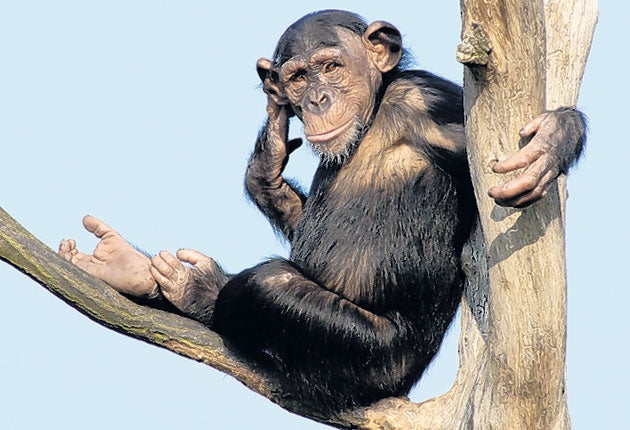Why our ancestors couldn't ape chimps
Study of climbing abilities disproves long-held belief that the earliest humans were able to scale trees as easily as primates

Humanity's immediate predecessors may have had trouble climbing trees, research suggests – so they may not have been as ape-like as many experts believe.
Scientists have arrived at this conclusion after making a close study of the way chimpanzees scale trees – virtually vertically and with ease – and then comparing chimpanzee ankle joints with those of hominins, humans' ancestors.
The hominins lived between 1.5 and 4.1 million years ago, a relatively short time after proto-humans and chimpanzees split from a common ancestor (generally thought to have been between four and eight million years ago). Many experts have argued that this ancestor was probably quite chimpanzee-like, and as a result it has been widely assumed that the earliest humans were ape-like, too.
But the research contradicts this idea, showing that – unlike modern chimps – ancient humans were not designed to climb trees. Dr Jeremy DeSilva, from the University of Michigan in Ann Arbor, came to this view after carrying out the first ever study of the mechanics of chimpanzees' tree-climbing abilities, using a group of animals in the Kibale National Park of western Uganda.
Dr DeSilva closely analysed videos to see whether the animals' skeletal motion was consistent with claims of early human climbing. Focusing on the ankle joint, he determined the angle of "dorsiflexion" – the degree to which the ankle rotates to point the toes upwards.
His research showed that dorsiflexion is far more extreme in chimps than humans: chimpanzees were capable of a 45-degree bend, whereas the range in humans was between 15 and 20 degrees.
To assist dorsiflexion, he found, the bottom of the chimpanzee tibia – the larger of the two bones in the lower leg – is shaped in a certain way where it joins the ankle. But when Dr DeSilva examined 12 fossil tibias from early hominins, he found no such adaptation.
Combined with other skeletal details, the evidence indicated that early human ancestors could not have been good climbers. Writing in the journal Proceedings of the National Academy of Sciences, Dr DeSilva says: "Early hominins may have climbed trees like modern humans can and occasionally do today; however, this study suggests that vertical climbing and arboreality were not significant parts of their locomotor repertoire."
He specifies: "Modern chimpanzees safely and effectively climb trees in part because they are capable of extreme dorsiflexion and inversion at the ankle joint. Although early hominins have been hypothesised to be adept tree climbers, none of the 29 known fossil tibiae or tali from 4.12 to 1.53 million years ago possesses the combination of features functionally correlated with vertical climbing in modern chimpanzees. If early hominins were engaging in any substantial amount of arboreal climbing, then they were doing it in a manner ... distinct from modern chimpanzees."
Join our commenting forum
Join thought-provoking conversations, follow other Independent readers and see their replies
Comments